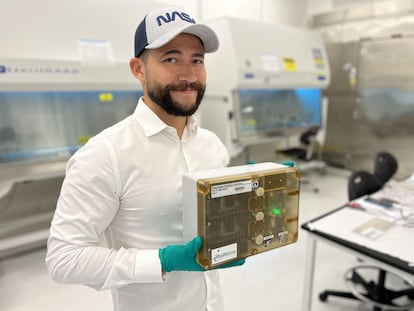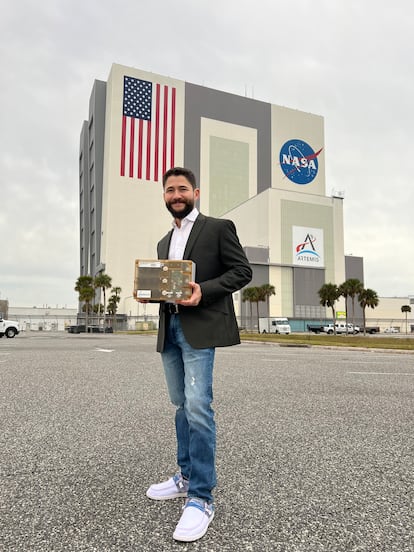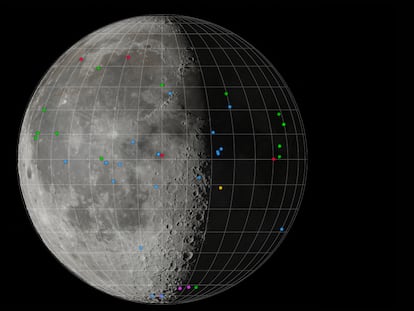Luis Zea, space bioengineer: ‘We cannot go to the Moon and Mars only to consume all the resources like on Earth’
In collaboration with NASA, the Guatemalan researcher from the University of Colorado sent ‘12,000 mutant yeasts’ around the satellite on the Orion spacecraft

When Luis Zea was a child, he enjoyed movies about space travel, but he believed that “I was never going to be a part of that.” While working to complete his research scholarship, he took advantage of his position near the NASA space center in Cape Canaveral (Florida) to watch rocket launches, and he felt excitement that maybe one day he would take part in something just as spectacular. Today, the Guatemalan sees the Moon differently than the majority of mankind, because he has had his work, his experiment, orbit around the Earth’s satellite on board NASA’s Orion spacecraft. He talks about his work via videoconference from his home in Boulder, where he has specialized in space bioengineering at the University of Colorado. Between interruptions by his two young daughters, he explains that he has sent “12,000 mutant yeasts around the Moon” to discover if, in the absence of gravity, a gene is activated that helps combat the mutations that cause cancer, because the fermentation cells in bread and beer are very similar to human cells.
Question. When you were little, did you dream of participating in the space program?
Answer. I didn’t get a scholarship because my school grades were very bad, but I got my act together later. So, I managed to get a scholarship through a mechanism in which, in addition to studying, I had to do research work, and I ended up in an oil company, near Cape Canaveral. Every time there was a launch, I went out to see it and I had the feeling that: one day, it will happen one day.
Q. And a few years later, an experiment of yours orbited the Moon. What does it involve?
A. What we did was fly approximately 12,000 mutant yeasts around the Moon in a device as big as a shoebox and intelligent and autonomous enough to know where it is in space in order to activate the experiment. It has a dosimeter with which we can identify the type and amount of space radiation that the yeasts received until they returned. Then we made a correlation to see which mutants, and which genes, were most successful in surviving under conditions that combined microgravity and radiation.
Q. For what reason?
A. There are several. One of the ones that interests me the most is the DNA repair system after receiving radiation, because yeast shares a lot of mechanisms with human cells. If we stand in the sun for a long time, ultraviolet radiation can change a letter in our cells’ genetic code, although generally the mechanism corrects this alteration and the cell duplicates itself properly and there is no problem. But when these changes are not corrected, they become one of the bases of cancer. In other words, when a mutation multiplies without control. Our long-term goal is to use the space environment find genes that are related to the activation or more efficient use of those repair mechanisms that we have never seen on Earth. And we did this in microgravity.
Q. And how important is gravity?
A. For 3.5 billion years, life on Earth has evolved with changes that occurred on the planet: the composition of the atmosphere, the salinity and pH of the sea, the temperature, the presence of volcanoes, and so on. But from the beginning there has been a single constant in the evolution of life: gravity. Now that we have the ability to take cells, organisms, and tissues into space, we can see things we have never seen here on Earth.

Q. For example?
A. In space we see molecular paths that we have never seen in experiments on Earth. It allows you to unmask molecular processes that you simply cannot achieve here on Earth, even if you stand on your head, because there is always gravity. And [we can] see if we find a gene that has allowed more efficient DNA repair under that microgravity environment and radiation exposure.
Q. This serves to take care of the health of astronauts, whose exposure to this space radiation comes from living outside the Earth’s atmosphere, but would it also have medical applications in cancer patients?
A. Yes. There are many people who have to go to radiotherapy, where part of their body is irradiated; and that damages healthy cells, not just cancerous ones. The question is, how could we help healthy cells survive these radiation treatments, without also helping cancerous cells? If, thanks to yeast, we can find a gene that can improve these DNA repair mechanisms, which is administered exclusively to healthy cells, that would be a potential solution.
Q. How does it work?
A. When you start looking at those cancer cells in the laboratory, they form a completely two-dimensional structure, it’s literally a plate. But when astronaut Peggy Whitson looked at them with the microscope on the International Space Station, it was a huge three-dimensional structure of cancer. It’s like the beginning of Star Trek, you see them as if you are flying through the stars. That’s one of the reasons we do cancer research in space, because you can build these three-dimensional structures that we can’t see on Earth because of gravity: here it’s like trying to build a structure with marbles, as soon as you put the second one in place, the whole thing collapses. This system helps reduce the number of false positives or false negatives when you are studying a molecule that may become a medicine. It is a process that costs an average of $1.2 billion and takes 10 years from the time someone finds a promising molecule until you have a product on the market to help people. If we can speed up that process and reduce its costs, it would have a very positive impact.

Q. How did you feel when you knew that your experiment was flying around the Moon?
A. When I wrote the proposal to submit, I knew that the probability of being approved to travel on the Orion spacecraft was super low, because it is very competitive; there are a lot of scientists with excellent degrees. But after finding out that our proposal had been selected, I never felt the same way again. Before taking off, I looked at the Moon and said to myself: ‘you are going to have a ship orbiting the Moon with our device, with our science.’ And now that it has returned, I feel the same: I look at it and say ‘wow!’, we sent something that happened 130 kilometers from the surface of the Moon, which was super far away, far beyond the Moon. Emotions change your perspective. I come from Guatemala, and I grew up watching movies and reading books and always thinking that I was never going to be able to be part of that.
Q. You have also published several studies on sustainability in space.
A. The objective is to make space exploration sustainable in two aspects. One, reduce supply chain demand for the things [astronauts] need from Earth, so that people can live independently off-planet: on the Moon, orbiting the Moon, on Mars, etc. And the second part of sustainability refers to the fact that in those places, we cannot do what humans have always done throughout history: we go to one place, consume all the resources and then go to the next, and so on over and over again. It is not sustainable, we are not doing the planet or ourselves any good. It is about ensuring that resources are used responsibly, keeping in mind that time passes and resources are finite. If you develop systems and processes that try to close the loop, it allows you to achieve those two types of sustainability and it is beneficial on both sides. My intention is to factor that in from the beginning, now that we are promoting space exploration with the intention of supporting ourselves, of establishing bases on the Moon, and that is a step towards something bigger: living there and then on Mars.
Q. By closing the cycle, do you mean something like the movie The Martian, in which the astronaut uses his own feces as fertilizer for the garden?
A. Correct. One example being worked on in my lab is called biomining, a process that tends to be more environmentally friendly, because you don’t need super powerful chemicals to extract metal from the regolith. It is about using bacteria or other types of organisms, which use the resources of the regolith to breathe and to eat. And they are happy, they are feasting and as part of that process of eating and excreting, they separate the metal that you want. And by extracting iron from the lunar regolith, for example, you can feed a 3D printer and build your tools: you no longer need pliers sent to you from Earth, you have your own production.
Q. However, the billionaires, like Elon Musk, who want to take us to Mars show a rather colonialist mentality.
A. I don’t know what these people’s mindset is when it comes to sustainability, but they need it from an engineering point of view. It is not sustainable to have that supply chain from Earth all the time. They are interested in reducing the amount of oxygen and water they consume. And that leads to the second aspect of sustainability, the responsible use of resources. One naturally leads to the other, I think they will realize that eventually.
Sign up for our weekly newsletter to get more English-language news coverage from EL PAÍS USA Edition
Tu suscripción se está usando en otro dispositivo
¿Quieres añadir otro usuario a tu suscripción?
Si continúas leyendo en este dispositivo, no se podrá leer en el otro.
FlechaTu suscripción se está usando en otro dispositivo y solo puedes acceder a EL PAÍS desde un dispositivo a la vez.
Si quieres compartir tu cuenta, cambia tu suscripción a la modalidad Premium, así podrás añadir otro usuario. Cada uno accederá con su propia cuenta de email, lo que os permitirá personalizar vuestra experiencia en EL PAÍS.
¿Tienes una suscripción de empresa? Accede aquí para contratar más cuentas.
En el caso de no saber quién está usando tu cuenta, te recomendamos cambiar tu contraseña aquí.
Si decides continuar compartiendo tu cuenta, este mensaje se mostrará en tu dispositivo y en el de la otra persona que está usando tu cuenta de forma indefinida, afectando a tu experiencia de lectura. Puedes consultar aquí los términos y condiciones de la suscripción digital.
More information
Archived In
Últimas noticias
Mustafa Suleyman: ‘Controlling AI is the challenge of our time’
Venezuela breaks energy agreements with Trinidad and Tobago due to alleged complicity with the US
The murder of Michele and Rob Reiner: A tale of horrific days in Hollywood
Trump orders a ‘complete blockade of sanctioned oil tankers’ going to and from Venezuela
Most viewed
- ‘El Limones’ and the growing union disguise of Mexican organized crime
- Christian Louboutin: ‘Young people don’t want to be like their parents. And if their parents wear sneakers, they’re going to look for something else’
- ‘We are dying’: Cuba sinks into a health crisis amid medicine shortages and misdiagnosis
- A mountaineer, accused of manslaughter for the death of his partner during a climb: He silenced his phone and refused a helicopter rescue
- The low-cost creative revolution: How technology is making art accessible to everyone











































